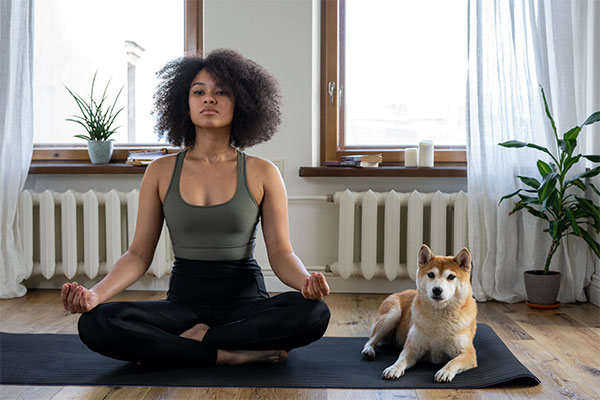Most people look forward to the festive season all year. Still, by the time it arrives, many of us are exhausted, and the additional stress of the holidays can take a toll on our health.
External stimuli bombard us during the holidays. As we focus on keeping everyone else happy, we often end up with very little time for ourselves and our own emotional needs.
If it feels as if your sanity is hanging by a thread, yoga and mindfulness meditation may be what you need to get through this hectic time of the year.

Why Yoga and Meditation?
Yoga and meditation can help us turn negative thoughts and experiences into positive ones. Meditation can assist you in the task of finding a place of stillness in yourself and become more aware of your body.
What is Mindfulness?
Mindfulness is about focusing on the present without worrying about the past or future. Anxiety is often the result of worrying over events that have already happened or are still to come.
If you can find a way to focus on one thing at a time, you will feel less stressed as it happens. You would still need to plan for the festive season but try not to think about what you should be doing next constantly.
You can practice mindfulness through meditation and by being aware of the things you do every day. Tune into your senses and become aware of your thoughts and emotions.
Learn Meditation
If you’re a newbie, start by meditating for about 5 to 10 minutes at a time. You can build up to 45 minutes or an hour. Many people do one session in the morning and one in the evening, but you can always do more when you have more time.
Find a space in your home that is as empty and quiet as possible, or you can even sit outside. Make sure that you are wearing comfortable clothes.
Consider following the practical steps below for your meditation sessions.
8 Steps for Mindfulness Meditation
- Sit on a stable surface.
- If you are sitting on the floor, the best position is to cross your legs. The bottoms of your feet should touch the floor if you are sitting on a chair. Relax your neck and tuck your chin in.
- Breathe deeply through your nose and mouth. Close your eyes the last time you exhale.
- Become aware of your body. Observe your posture and the sensations where your body touches the chair. Take notice of what you can smell, taste, or hear, and if you can feel heat or cold.
- Take note of any discomfort or tension in your body. After a few seconds, notice what parts of your body feel relaxed. Also, become aware of your thoughts and mood.
- Monitor your breathing and the physical sensation of the air moving in and out of your nose and mouth. Are your breaths deep or shallow, long or short, fast or slow? Count your breaths, and if you find your mind wandering, return your attention to your breathing.
- If your mind keeps on wandering, observe without reacting.
- Open your eyes when you’re ready and pay attention to what’s happening in the environment and how your body feels. Also, notice your thoughts and emotions and decide how you want to continue your day. Before you get up, form a clear idea of what you’re going to do next so that you don’t lose the calmness you’ve managed to create.
Try to remind yourself throughout the day what it felt like to be calm with a clear mind. It’s unnecessary to do the entire exercise again; just take some deep breaths if you start to feel stressed.
Do Yoga When You Can
Many of us feel we don’t have time for our yoga classes during the busy festive season, but this is when we need them the most. It may feel as if relaxing or balancing in a pose takes you away from other things you need to be doing, but you’ll have a clearer mind and more energy afterward to tackle your tasks.
Try to practice for short times during your day, such as when you’re waiting for someone or have dinner in the oven. You’ll find that only a few stretches will relax you. Try to focus on areas where you feel you carry tension.
Slowing Down
Yoga not only helps you relax but also to sleep better. It can slow down your mind, and you’ll be able to focus on one thing at a time.
Some of the poses, known as asanas, work well when it comes to relieving stress. The child’s pose eases tension in your shoulders while stretching your back and helps you turn inward mentally since your forehead is facing the floor. The bridge pose helps relieve headaches and is also suitable for your back.
Yoga sessions usually end with the savasana pose, where you are lying on your back, relaxed.
Final Thoughts
It’s essential to realize that we don’t always have to be busy socializing or trying to please other people during the festive season. We also need to rest and restore ourselves mentally and physically for the coming year.
Practicing yoga and meditation provides you with the perfect opportunity to spend time with yourself and ensure that you are reinvigorated for the festivities and another busy year ahead.










